This article needs additional citations for verification .(March 2023) |

The Otakars (or von Traungaus, or Traungauer [1] ) were a medieval dynasty ruling the Imperial March of Styria (later the Duchy of Styria) from 1056 to 1192. [1] [2]
This article needs additional citations for verification .(March 2023) |

The Otakars (or von Traungaus, or Traungauer [1] ) were a medieval dynasty ruling the Imperial March of Styria (later the Duchy of Styria) from 1056 to 1192. [1] [2]
The dynasty began with Otakar I, probably a son or son-in-law of Aribo (c. 850 –909), margrave in Pannonia under King Arnulf. Otakar was Count of Steyr in the Traungau, in what is today Upper Austria. Together with Margrave Luitpold, he may have been killed at the 907 Battle of Pressburg. His descendant Ottokar I (died 1064), Count in the Chiemgau, [2] became ruler of the Carantanian march in 1056.
The Carantanian march, then subject to the Duchy of Carinthia, was subsequently named March of Styria (German : Steiermark) after the dynasty's original seat at Steyr. In 1180 Margrave Ottokar IV gained the ducal title from Emperor Frederick I Barbarossa, thereby establishing the Duchy of Styria. [1] The reign of the Otakars however ended with the extinction of the line upon Duke Ottokar's death in 1192. In the Georgenberg Pact of 1186 he had agreed that his lands should pass to Leopold V, the Babenberg duke of Austria.

Year 1056 (MLVI) was a leap year starting on Monday of the Julian calendar.

The House of Babenberg was a noble dynasty of Austrian Dukes and Margraves. Originally from Bamberg in the Duchy of Franconia, the Babenbergs ruled the imperial Margraviate of Austria from its creation in 976 AD until its elevation to a duchy in 1156, and from then until the extinction of the line in 1246, whereafter they were succeeded by the House of Habsburg.

Rudolf I was the first King of Germany from the House of Habsburg. The first of the count-kings of Germany, he reigned from 1273 until his death in 1291.

The Duchy of Carinthia was a duchy located in southern Austria and parts of northern Slovenia. It was separated from the Duchy of Bavaria in 976, and was the first newly created Imperial State after the original German stem duchies.

Ottokar I was Duke of Bohemia periodically beginning in 1192, then acquired the title of King of Bohemia, first in 1198 from Philip of Swabia, later in 1203 from Otto IV of Brunswick and in 1212 from Frederick II. He was an eminent member of the Přemyslid dynasty.

Ottokar II, the Iron and Golden King, was a member of the Přemyslid dynasty who reigned as King of Bohemia from 1253 until his death in 1278. He also held the titles of Margrave of Moravia from 1247, Duke of Austria from 1251, and Duke of Styria from 1260, as well as Duke of Carinthia and landgrave of Carniola from 1269.

Steyr is a statutory city, located in the Austrian federal state of Upper Austria. It is the administrative capital, though not part of Steyr-Land District. Steyr is Austria's 12th most populated town and the 3rd largest city in Upper Austria.
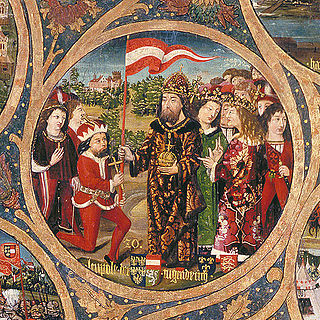
Leopold V, known as the Virtuous was a member of the House of Babenberg who reigned as Duke of Austria from 1177 and Duke of Styria within the Holy Roman Empire from 1192 until his death. The Georgenberg Pact resulted in Leopold being enfeoffed with Styria by Roman-German Emperor Frederick Barbarossa in 1193, which would lead to the eventual creation of modern Austria. Leopold was also known for his involvement in the Third Crusade where he fought in the Siege of Acre in 1191 and of his imprisonment of King Richard I in 1193 at Dürnstein Castle.

The Georgenberg Pact was a treaty signed between Duke Leopold V of Austria and Duke Ottokar IV of Styria on 17 August 1186 at Enns Castle on the Georgenberg mountain.
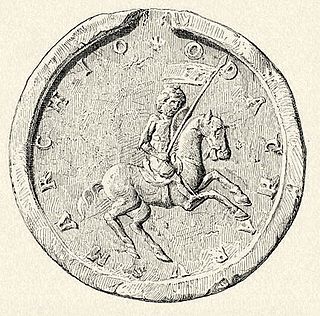
Ottokar IV, a member of the Otakar dynasty, was Margrave of Styria from 1164 and Duke from 1180, when Styria, previously a margraviate subordinated to the stem duchy of Bavaria, was raised to the status of an independent duchy.
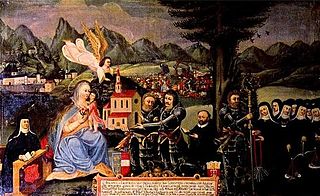
Ottokar I, also Otakar was count in the Bavarian Chiemgau and Margrave of Styria from 1056 until his death. He became progenitor of the dynasty of the Otakars.
Ottokar is the medieval German form of the Germanic name Audovacar.
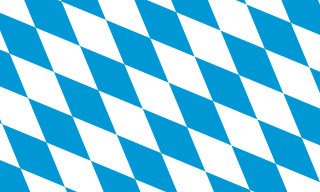
The Duchy of Bavaria was a frontier region in the southeastern part of the Merovingian kingdom from the sixth through the eighth century. It was settled by Bavarian tribes and ruled by dukes (duces) under Frankish overlordship. A new duchy was created from this area during the decline of the Carolingian Empire in the late ninth century. It became one of the stem duchies of the East Frankish realm, which evolved as the Kingdom of Germany and the Holy Roman Empire.

The Duchy of Austria was a medieval principality of the Holy Roman Empire, established in 1156 by the Privilegium Minus, when the Margraviate of Austria (Ostarrîchi) was detached from Bavaria and elevated to a duchy in its own right. After the ruling dukes of the House of Babenberg became extinct in male line, there was as much as three decades of rivalry on inheritance and rulership, until the German king Rudolf I took over the dominion as the first monarch of the Habsburg dynasty in 1276. Thereafter, Austria became the patrimony and ancestral homeland of the dynasty and the nucleus of the Habsburg monarchy. In 1453, the archducal title of the Austrian rulers, invented by Duke Rudolf IV in the forged Privilegium Maius of 1359, was officially acknowledged by the Habsburg emperor Frederick III.

The Marchof Carniola was a southeastern state of the Holy Roman Empire in the High Middle Ages, the predecessor of the Duchy of Carniola. It corresponded roughly to the central Carniolan region of present-day Slovenia. At the time of its creation, the march served as a frontier defense against the Kingdoms of Hungary and Croatia.

The Margraviate of Austria was a medieval frontier march, centered along the river Danube, between the river Enns and the Vienna Woods, within the territory of modern Austrian provinces of Upper Austria and Lower Austria. It existed from c. 970 to 1156.

The March of Styria, originally known as Carantanian march, was a southeastern frontier march of the Holy Roman Empire. It was broken off the larger March of Carinthia, itself a march of the Duchy of Bavaria, around 970 as a buffer zone against the Hungarian invasions. Under the overlordship of the Carinthian dukes from 976 onwards, the territory evolved to be called Styria, so named for the town of Steyr, then the residence of the Otakar margraves. It became an Imperial State in its own right, when the Otakars were elevated to Dukes of Styria in 1180.

The Duchy of Styria was a duchy located in modern-day southern Austria and northern Slovenia. It was a part of the Holy Roman Empire until its dissolution in 1806 and a Cisleithanian crown land of Austria-Hungary until its dissolution in 1918.
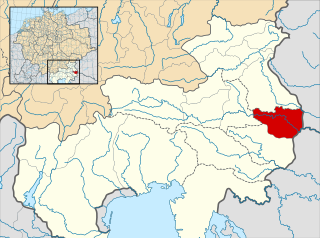
The Mark an der Drau was a historical territory of the Holy Roman Empire and its predecessors during the Middle Ages. It came into being during the second half of the 10th century, covering an area from the eastern border of the Carolingian Carantanian Gaugrafschaft of Jauntal to Pettau in the territory of Friedau (Ormož). After 1147 it was attached to the Mark an der Mur forming the March of Styria/Carantania, which later gave rise to the Duchy of Styria. Other designations for the territory include Mark Pettau, Mark hinter dem Drauwald, Grafschaft hinter dem Drauwald, Marchia transsilvana/transsylvana, Pitouiensis, and untere Karantaner Mark.

The imperial election of 1273 was an imperial election held to select the emperor of the Holy Roman Empire. It took place in Frankfurt on October 1.